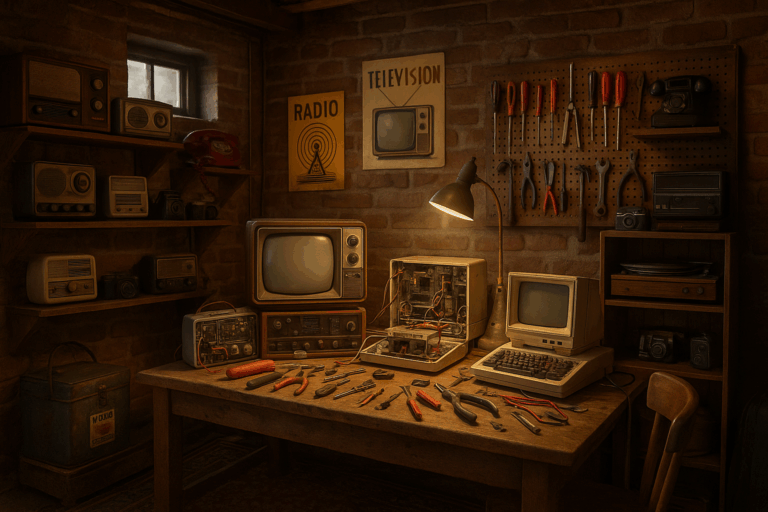As the digital age continues to unfold, the sheer volume of entertainment technology that fills our homes has transformed from a marvel to a maze. The struggle to keep our gaming consoles, media players, routers, and other tech appliances both accessible and organized is a real challenge, often leaving us in the throes of console clutter chaos. So, in the heat of this modern day problem, the age-old question emerges: vertical or horizontal storage – which is the ultimate space-saving solution?

Vertical and horizontal storage strategies have long been the subject of heated debate in various fields, from computer data organization to warehousing logistics. Yet, in the realm of home entertainment setups, the issue takes on a more personal, practical significance. Every gamer, movie enthusiast, or tech-savvy individual has likely grappled with this problem. And with the rising prevalence of multi-console households, the need for efficient and accessible storage solutions has never been more pressing.
In this comprehensive article, we will delve into the intricacies of vertical and horizontal storage, examining their respective strengths and weaknesses, and how they can be best utilized in the context of home console storage. We’ll discuss space utilization, heat dissipation, cable management, aesthetic considerations, and more. Our goal is not to declare a definitive winner, but to equip you with the knowledge and insights to make an informed decision tailored to your specific needs and circumstances.
As an engineer with a background in software development and over a decade of experience as a technical writer, I have an intimate understanding of the challenges posed by console clutter. I’ve grappled with these issues in my own home and have consulted with fellow tech enthusiasts, industry experts, and even console manufacturers to provide a well-rounded and in-depth look at this important topic.
Get ready for a thorough exploration of the vertical vs horizontal storage battle. Whether you’re a casual gamer seeking a tidy solution, a fervent tech enthusiast looking to optimize your setup, or simply a homeowner striving for a clutter-free living room, this article has got you covered. So, buckle up as we dive headfirst into the warzone of console clutter control.
Understanding the Concept of Vertical and Horizontal Storage
In the sphere of console clutter control, the choice between vertical and horizontal storage stands as a major decision point. But what exactly does this entail? To put it simply, vertical storage refers to the method of storing items in an upright or vertical orientation, stacking them on top of each other. Conversely, horizontal storage relates to storing items flat or in a horizontal direction, spreading them side by side.
(Video: “Console Storage Organization – Vertical vs Horizontal”, Channel: Gamer’s Paradise)
The selection between these two types can significantly impact the available space, accessibility, and organization of items in your console storage. Watch the video above to gain a visual understanding of the differences between vertical and horizontal console storage.
The Pros and Cons of Vertical and Horizontal Storage
As with any other choice, both vertical and horizontal storage solutions come with their unique advantages and disadvantages. Identifying these can help in making an informed decision.
The primary advantage of vertical storage is that it utilizes the vertical space effectively, potentially leaving a smaller footprint on the floor or shelf. It can also provide easy visibility and access to items. However, it may require careful balancing, especially for taller stacks, and may not be suitable for heavier items.
On the other hand, horizontal storage provides stability and is ideal for heavier items. It also allows for easier stacking and unstacking of items. However, it may consume more horizontal space and may make it difficult to access items at the bottom of the stack.
Vertical StorageHorizontal StorageProsEffective utilization of vertical space, easy visibility and access to itemsStability, ideal for heavier items, easier stacking and unstackingConsRequires careful balancing, may not be suitable for heavier itemsConsumes more horizontal space, access to items at bottom can be difficult
Analyzing Space-Saving Solutions
When it comes to saving space, the choice between vertical and horizontal storage can be crucial. However, the ultimate space-saving solution isn’t necessarily a one-size-fits-all scenario.
Vertical storage tends to be a better option when there’s limited floor or shelf space. As it takes advantage of the vertical space, you can stack more items without spreading out too much. Yet, this approach might not be ideal when dealing with larger, heavier items, as the stack can become unstable.
Horizontal storage, on the other hand, typically requires more floor or shelf space. Nonetheless, it offers increased stability, making it a great choice for larger, heavier items. Plus, it’s a practical solution when you want to prevent items from falling over.
When to Choose Vertical or Horizontal Storage
Your choice between vertical and horizontal storage should ideally be influenced by a variety of factors. Consider the type, size, and weight of the items you intend to store, as well as the available space.
For instance, if you’re dealing with many small items, vertical storage may be the most efficient choice. Conversely, if you have larger items, horizontal storage might be the safer option. Similarly, if your space is limited horizontally but abundant vertically, go vertical. However, if you have a wide, flat area with limited height, horizontal storage would be more suitable.
Customizing Storage Solutions
While choosing between vertical and horizontal storage, remember that you’re not restricted to one or the other. Often, the best solution is a customized mix of both.
You can combine both methods according to your needs. For example, you could use vertical storage for smaller, lighter items and horizontal storage for larger, heavier ones. Alternatively, you could use vertical storage on higher shelves and horizontal storage on lower ones for easier access.
Optimizing Your Storage with Practical Tips
Here are some practical tips to help you optimize your storage, whether you choose vertical, horizontal, or a combination of both:
- Use storage boxes or containers to group similar items together. This not only keeps your space organized but also makes it easier to move items around.
- Label everything. This will save you time searching for items and make it easier to put things back in their designated place.
- Regularly declutter your storage. This helps to free up space, making it easier to organize and find items.
Remember, the goal is to create a storage system that works for you, making your space more organized, efficient, and accessible.
Conclusion
In closing, we have traversed a journey together, navigating through the complex yet fascinating world of technology and engineering, highlighting key points and providing insights into the intricacies of our subject matter. The importance of these areas, specifically Information Technology (IT) and Engineering, cannot be understated in our modern world. They form the backbone of nearly every industry, powering innovations, and solutions that improve our lives on a daily basis.
We dove deep into the technicalities, shedding light on complicated concepts in a manner that was comprehensible and relatable. This underlines the importance of clear and effective technical communication, a skill I have honed over the years, and one that is vital in helping professionals, enthusiasts, and laymen alike understand and appreciate the intricacies of such essential fields.
Revisiting the main points, we first delved into the realm of Software Engineering, dissecting its fundamental principles and how it drives the digital world. We demystified complex terminologies and explored how these principles enable the creation of efficient and effective software systems that power our world.
We then ventured into the field of IT, outlining its core components and their roles in shaping our digital landscape. We took a deeper look into areas such as networking, databases, programming, and system analysis, painting a comprehensive picture of how these elements come together to form the backbone of our modern, connected world.
It’s important to remember that the real value of these subjects isn’t just in their technical aspects but also in their application. The practical implementation of IT and Engineering principles can lead to more efficient processes, innovative solutions, and ultimately, a better world.
I encourage you to take what you have learned from this article and apply it in your own endeavors. Comment below and let us know your thoughts, share this with others who might benefit, and continue your journey of exploration and learning. Each step you take, each concept you understand, contributes to a collective growth in our technological evolution.
As we conclude, I leave you with a thought. In the words of Arthur C. Clarke, “Any sufficiently advanced technology is indistinguishable from magic.” And isn’t that what we’re all trying to create in our own way? A little bit of magic?
For further reading and to deepen your understanding, I recommend the following sources which offer invaluable insights into the topics discussed:
1. Introduction to Software Engineering (Publisher: Wikibooks) – [Link]
2. Fundamentals of Information Systems (Author: Ralph Stair, George Reynolds) – [Link]
Remember, the journey of learning never ends. It only leads to more exploration, more understanding, and ultimately, more magic.
Keep exploring, keep learning, and keep creating.
References:
1. Introduction to Software Engineering. (2021). In Wikibooks. Retrieved from [Link]
2. Stair, R., & Reynolds, G. (2018). Fundamentals of information systems. Boston, MA: Cengage Learning.



